A Service-Learning Project to Acquire GIS Skills and Knowledge: A Case Study for Environmental Undergraduate Students
Abstract
1. Introduction
1.1. Service Learning as an Educational Tool at University
1.2. Study Population
1.3. Objectives
- Students will use a mobile application to locate points in the field using the Global Navigating Satellite System (GNSS).
- Students will learn how to apply spatial operations using GIS to the data obtained by the students themselves.
- Students will draw conclusions from the results obtained and how to present them to deliver to City Council’s environment technician.
- Students awareness of the existing waste problems in cities will increase.
2. Methods
2.1. The Structure of the Project
2.1.1. Predesign
- Elaboration of a list of possible activities to be performed within the course Cartography, Remote Sensing, and GIS using SL methodology.
- Searching for organizations to offer the product (the Service). The City Council was selected.
- Searching for contacts within the area/service of the City Council.
- Preparation of a proposal to be presented to the technical staff of the City Council.
- Sharing the proposal with the technical staff of the Municipality to determine the common objectives and the characteristics of the final product; while they share with us an old database with spatial data related to all types of waste recipients distributed in the municipality.
2.1.2. Design of the SL Activity
- Designing a project presentation for the students of the 2019–20 academic year.
- Adjusting the theoretical classes schedule to perform the activity.
- Elaboration of training scripts to be followed autonomously.
- Elaboration of training scripts for analysis in the classroom.
2.1.3. Execution
- Session 1 (directed): presentation of the activities to be performed and their schedule and evaluation method.
- Session 2 (autonomous): during this session, the students measure the coordinates of the rubbish bins and other waste containers along approximately 1 km of the Bernesga riverbank using a GNSS-based application for cell phones and following a detailed training script provided by the professors. Data collection is performed in pairs chosen by the students, while the study area section is assigned by the professors. This assignment and the training script are sent to the students 2 weeks in advance to give them enough time to plan their field work. Once the data are collected, each pair of students upload them to a Google Drive folder to share data with the rest of the students.
- Session 3 (directed): the purpose of this session is to share the data collected in the field and to start data processing. The students download their own and their classmates’ data, import them into the computer, share the problems encountered, and reach an agreement on how to homogenize all the imported data. Finally, they create a map and present it as part of the ongoing evaluation. They need to unify attribute data, therefore showing the importance of collaborative work.
- Session 4 (directed): its objective is to prepare data from different sources—some freely available (OpenStreetMap) and other with restricted access (data from the City Council)—and begin the spatial analysis of the data and associated tables. Some of these activities create the basis for the students to later conduct the analysis of the data collected in the field in Session 5.
- Session 5 (autonomous): students work in pairs once again to create a proposal for the location of new rubbish bins along the riverbank according to the analyses performed during the previous session. As a result, each pair creates two documents: a collective one including the methods used and results obtained throughout the practice and an individual one consisting of a final map. Professors used both of them in their evaluation, as explained below.
- Session 6 (autonomous): its objective is to evaluate the maps created by the students. For this purpose, the students are divided into three large groups (between 22 and 23 pupils per group). Each student autonomously evaluates the individual resulting maps of his or her group and the best three are selected. A rubric is provided for students to perform their evaluation (Table A1). As a result, 9 maps were selected as the best ones.
- Session 7 (directed): the purpose of this last session is to collectively prepare the document to be presented to the City Council of León. For this session, the professors prepare an initial document combining the different student contributions from session 5. If the proposed methods of analysis or the results obtained include different opinions, these are kept in the initial document of this session share and discuss them among all the students. An agreement must be reached -reinforcing the collaborative working competence- regarding the following topics to be included in the document to be submitted to the City Council:
- ○
- Initial problems found reflecting on the waste issues in the city and suitability of the study to be performed in the city of León;
- ○
- Protocol to be followed for data collection;
- ○
- Analysis method;
- ○
- Final map with new rubbish bins locations: the vote was taken in person during this session among the 9 best cartographic maps selected in session 6 (Figure 2).
- Reflective activity about (i) problems encountered, (ii) potential improved methods to apply in the future and (iii) waste issues in the city.
2.1.4. Post-Maintenance
2.2. Student Observations and Outcomes
- 3 dog waste bins;
- 193 rubbish bins;
- 12 glass waste containers;
- 1 clothing and footwear waste container;
- 1 battery waste container;
- 16 paper and cardboard waste containers;
- 40 mixed (organic and general) waste containers;
- 21 plastic waste containers;
- 6 building material waste containers.
- The use of different terminology to characterize the waste collection points. Some students did not follow the training script and improvised the name of each element, which caused many problems when joining the data from the different river sections. This heterogeneity in the description of the points forced the students to homogenize the data in the classroom for subsequent analyses.
- The repetition of data collection at the limits of the sections of the study area, as some pairs of students did not respect the limits of their assigned section. This led to point duplications characterized in different manners.
- Errors in the coordinates of the rubbish bins/containers due to the GNSS receiver and the presence of garden areas with an abundance of foliage that hindered data acquisition by increasing the GNSS error margin. In both cases, points were moved manually based on the orthoimage. Those groups who worked more meticulously completed this modification during the data acquisition phase, while those pairs who did not give the due importance to this process had to fix the data during session 3 in the classroom.
- The presence of different types of waste containers close together. This situation led some pairs to add one point per container, while others assigned one single point with a long description, so that data needed to be homogenized later in the classroom.
2.3. Evaluation
3. Results
- Although out of the 67 students only 10 completed the survey, most of them show a high satisfaction with the work done. On a scale of 1 to 4 (from least to most satisfied), all of them consider that their knowledge about the potential of GIS has increased, with a value of 3–4.
- Of note, 9 out of 10 students consider that their knowledge on how to design studies with GIS has increased. This is an instrumental subject, and it is vital that they know not only how to operate the software but also how to organize and analyze the data. In previous years, this knowledge was achieved, too, but students required more time.
- Curiously, while expressing satisfaction with the acquired knowledge, 60% of the surveyed students feel that the project did not contribute significantly to their comprehension of the GIS component of the course.
- In terms of teamwork learning, they feel that this practice has given them little benefit.
- Of all the respondents, 80% value positively the use of other tools that used throughout the project, such as Google Drive or the GNSS application for mobile data collection.
- Of those surveyed, 60% of students consider that the result can be of some use to the City Council of León.
- 70% of the respondents would advise keeping this type of project in the course for following years.
- In the last open-ended question, 6 out of the total 10 surveys stressed that the biggest problem encountered with this learning approach for the students is the amount of work and that the deadline for the final report coincided with other deadlines or exams from other courses. However, note that the initial deadline for the final report was December 21, but due to the amount of work the students had to do, this was postponed to January 8. Still, students consider that these were not the most appropriate dates.
- Identification of hazardous areas within the city’s bikeways and assessment of a potential extension.
- Localization of urban drinking-water sources and new ones proposal.
- Fossil route in the city of León.
- Localization of bus stops in the city and new ones proposal.
- Analysis of green areas in relation to the population density in different districts in the city.
4. Discussion
5. Conclusions
- The use of this type of project facilitates the teaching of techniques within the objectives of the course and also of the collection and implementation processes that this type of techniques requires, that is a much deeper and closer to the professional experience knowledge.
- At an academic level, the project goals were achieved, and the results have improved compared with those of previous years, although these are still far from satisfactory for a third-year undergraduate course. In any case, part of this academic issue is structural, since this is also observed as a general trend when considering the average number of credits from all courses obtained by all undergraduate students.
- The City Council technician was satisfied with the implementation of this SL project. Pleased with the results, she planned to incorporate them into future studies and requested ongoing collaboration for upcoming initiatives.
- The fact of working with problems close to the students, such as urban waste, makes it easier to reflect on these problems throughout the project.
Author Contributions
Funding
Data Availability Statement
Acknowledgments
Conflicts of Interest
Appendix A
| Maximum Value | |
|---|---|
| Cartographic elements | 5 |
| Legend: good design, without orthographic errors and showing only elements represented in the map | 1 |
| North | 0.5 |
| Scale | 0.5 |
| Coordinate grid | 0.5 |
| Text with referenced cartographic system. Avoiding mixture of languages | 0.5 |
| Title: clear, brief and concise | 1 |
| Inclusion of reference map to facilitate localizing the study area | 1 |
| Use of different data frames | 1 |
| Evaluate if different data frames have been used as suggested in the training material | 1 |
| Symbology | 3 |
| Easy reading of the map, so you should consider the adequacy of symbol type, size and color. To evaluate these issues, consider the map scale: if you need a zoom in higher than the map scale to read the symbol, the symbology is not right. | 3 |
| Cartographic composition | 1 |
| Distribution of the cartographic elements in the final sheet, readability and pleasant design | 1 |
| Total | 10 |
| 0–4 | 5–7 | 8–10 | |
|---|---|---|---|
| Introduction | Text without context, so it is difficult for the reader to know what is the writing about | Poor context about the problem that they are going to solve in the script. | Good description of the problem, with the background in León city. |
| Data collection | List of the problems found during the practice without description of their source | Brief explanation of some problems found during the practice giving some details about their possible origin; a list of different ideas to follow as a protocol | Description of the problems found during the practice with an analysis of their origin; detailed protocol proposal. |
| Flow chart | Lack of some important operations; illogical flow; messy presentation | Lack of some analytical operations; logical flow but messy presentation | Every analytical operation included; logical flow, easy to follow; clear presentation. |
| Analysis of the results | Information not always relevant; some questions not addressed; not well understood most of the GIS operations | Relevant information; not well understood some of the GIS operations | Relevant information, deep analysis of GIS operations |
| Map | See Rubric of maps (Table A1) | ||
| Writing | Paper is difficult to read; not well organized; text does not follow a logical order; grammar mistakes; problems to understand the concepts. | Some paragraphs not fully developed; sometimes, reader gets lost, text is not clear; some concepts are used out of context; there are few grammar mistakes. | Well-organized text; easy to read, following a logical flow; excellent use of concepts; without grammar mistakes. |
References
- National Academies of Sciences, Engineering, and Medicine. Service-Learning in Undergraduate Geosciences: Proceeding of the Workshop on Service-Learning in Undergraduate Geosciences; The National Academies Press: Washington, DC, USA, 2017. [Google Scholar] [CrossRef]
- Dicke, L.; Dowden, S.; Torres, J. Successful service learning: A matter of ideology. J. Public Aff. Educ. 2004, 10, 199–208. [Google Scholar] [CrossRef]
- Furco, A.; Norvell, K. What is service learning? In Embedding Service Learning in European Higher Education; Routledge: London, UK, 2019. [Google Scholar] [CrossRef]
- Puig, J.M.; Gijón, M.; Martín-García, X.; Rubio, L. Aprendizaje-servicio y Educación para la ciudadanía. Rev. Educ. 2011, 45, 45–67. [Google Scholar]
- Bringle, R.; Hatcher, J. Institutionalization of service learning in higher education. J. High Educ. 2000, 71, 273–290. [Google Scholar] [CrossRef]
- Sánchez, M.E.; Hernández, Y.; Hernández, S. Innovación docente en recursos humanos a través del aprendizaje-servicio. Una experiencia piloto. RIDAS Rev. Iberoam. Aprendiz. Serv. 2019, 7, 1–16. [Google Scholar] [CrossRef]
- Sotelino-Losada, A.; Santos, M.A.; Priegue, D. Service-learning and employability. A view from the major areas of scientific knowledge. Procedia Soc. Behav. Sci. 2014, 139, 93–101. [Google Scholar] [CrossRef][Green Version]
- Aramburuzabala, P.; Cerrillo, R. Service-Learning as an approach to educating for sustainable development. Sustainability 2023, 15, 11231. [Google Scholar] [CrossRef]
- Chaumba, J. Improving student’s mineral and rock identification skills through service-learning. J. Community Engagem. High. Educ. 2022, 14, 58–69. [Google Scholar] [CrossRef]
- UNESCO. Skills for Holistic Human Development (THA/DOC/EPR/14/040-500). UNESCO Bangkok 2014. Volume 2. Available online: https://unesdoc.unesco.org/ark:/48223/pf0000245064/PDF/245064eng.pdf.multi (accessed on 17 December 2024).
- Folgueiras, P.; Aramburuzabala, P.; Opazo, H.; Mugarra, A.; Ruiz, A. Service-learning: A survey of experiences in Spain. Educ. Citiz. Soc. Justice 2018, 15, 162–180. [Google Scholar] [CrossRef]
- Sotelino-Losada, A.; Arbués-Radigales, E.; García-Docampo, L.; González-Geraldo, J.L. Service-Learning in Europe. Dimensions and understanding from academic publication. Front. Educ. 2021, 6, 604825. [Google Scholar] [CrossRef]
- Hasan, A.; Ali, I.; Khan, M.A.; Hamid, K. A study of university students’ motivation and its relationship with their academic performance. Int. J. Bus. Manag. 2010, 5, 80–86. [Google Scholar] [CrossRef]
- Wutzdorff, A.; Giles, D. Chapter VIII: Service-learning in higher education. Teach. Coll. Rec. 1997, 98, 105–117. [Google Scholar] [CrossRef]
- Salam, M.; Iskandar, D.N.A.; Ibrahim, D.H.A.; Farooq, M.S. Technology integration in service-learning pedagogy: A holistic framework. Telemat. Inform. 2019, 38, 257–273. [Google Scholar] [CrossRef]
- Sánchez-Carracedo, F.; López, D. A service-learning based computers reuse program. Sustainability 2021, 13, 7785. [Google Scholar] [CrossRef]
- Queiruga-Dios, M.; Santos Sánchez, M.J.; Queiruga-Dios, M.Á.; Acosta Castellanos, P.M.; Queiruga-Dios, A. Assessment methods for service-learning projects in engineering in higher education: A systematic review. Front. Psychol. 2021, 12, 629231. [Google Scholar] [CrossRef] [PubMed]
- Elumalai, K.V.; Sankar, J.P.; Kalaichelvi, R.; John, J.A.; Menon, N.; Alqahtani, M.S.M.; Abumelha, M.A. Factors affecting the quality of e-learning during the COVID-19 pandemic from the perspective of higher education students. J. Inf. Technol. Educ. Res. 2021, 19, 731–753. [Google Scholar] [CrossRef]
- Dapena, A.; Castro, P.M.; Ares-Pernas, A. Moving to e-service learning in higher education. Appl. Sci. 2022, 12, 5462. [Google Scholar] [CrossRef]
- Keen, C.; Baldwin, E. Students promoting economic development and environmental sustainability: An analysis of the impact of involvement in a community-based research and service-learning program. Int. J. Sustain. High. Educ. 2004, 5, 384–394. [Google Scholar] [CrossRef]
- Martínez, M. (Ed.) Aprendizaje Servicio y Responsabilidad Social de las Universidades; Ediciones Octaedro-ICE: Barcelona, Spain, 2008. [Google Scholar]
- Tapia, M.N. Calidad académica y responsabilidad social: El aprendizaje servicio como puente entre dos culturas universitarias. In Aprendizaje Servicio y Responsabilidad Social de las Universidades; Martínez, M., Ed.; Ediciones Octaedro-ICE: Barcelona, Spain, 2008; pp. 27–56. [Google Scholar]
- Hernández-Barco, M.; Sánchez-Martín, J.; Blanco-Salas, J.; Ruiz-Téllez, T. Teaching down to earth—Service-learning methodology for science education and sustainability at the university level: A practical approach. Sustainability 2020, 12, 542. [Google Scholar] [CrossRef]
- Alonso Tapia, J.; Fernández, J. Development and initial validation of the Classroom Motivational Climate Questionnaire (CMCQ). Psicothema 2008, 20, 883–889. [Google Scholar]
- Alonso Tapia, J.; Pardo, A. Assessment of learning environment quality from the point of view of secondary and high-school learners. Learn. Instr. 2006, 16, 295–309. [Google Scholar] [CrossRef]
- Singh, K. Study of achievement motivation in relation to academic achievement of students. Int. J. Educ. Plan. Adm. 2011, 1, 161–171. [Google Scholar]
- Cebrián, G.; Fernández, M.; Fuertes, M.T.; Moraleda, A.; Segalàs, J. The influence of service-learning on the development of sustainability competencies amongst university students. Bordón 2019, 71, 151–167. [Google Scholar] [CrossRef]
- Sánchez-Barroso, G.; González-Domínguez, J.; García-Sanz-Calcedo, J.; Zamora-Polo, F. Analysis of learning motivation in Industrial Engineering teaching in University of Extremadura (Spain). Sustainability 2020, 12, 4987. [Google Scholar] [CrossRef]
- UNESCO. World Conference on Higher Education. Final Report. UNESCO 2009. Available online: https://unesdoc.unesco.org/ark:/48223/pf0000189242 (accessed on 17 December 2024).
- García-Laso, A.; Marín, D.A.; Costafreda, J.L.; Nuñez, E.; Rodríguez, J.A. Aprendizaje-Servicio (ApS) como metodología para alcanzar los Objetivos de Desarrollo Sostenible (ODS). In Proceedings of the V Congreso Internacional Sobre Aprendizaje, Innovación y Cooperación, Zaragoza, Spain, 9–11 October 2019. [Google Scholar]
- United Nations. Resolution Adopted by the General Assembly on 25 September 2015. A/RES/70/1. Available online: https://www.un.org/en/development/desa/population/migration/generalassembly/docs/globalcompact/A_RES_70_1_E.pdf (accessed on 17 December 2024).
- Aramburuzabala, P.; Cerrillo, R.; Tello, I. Aprendizaje-servicio: Una propuesta metodológica para la introducción de la sostenibilidad curricular en la universidad. Profr. Rev. Currícul. Form. Profr. 2015, 19, 78–95. [Google Scholar]
- Conferencia de Rectores de las Universidades Españolas (CRUE). Directrices Para la Introducción de la Sostenibilidad en el Curriculum. CRUE 2012. Available online: https://www.crue.org/Documentos%20compartidos/Declaraciones/Directrices_Sosteniblidad_Crue2012.pdf (accessed on 17 December 2024).
- Schneller, S. Environmental service learning: Outcomes of innovative pedagogy in Baja California Sur, Mexico. Environ. Educ. Res. 2008, 14, 291–307. [Google Scholar] [CrossRef]
- Calvo Galván, M.L.; Centeno Martín, M.L.; Colmenero Hidalgo, E.; García García, P.; Fernández Villadangos, A.; López Campano, L.; Martínez, M.M.; Vieira, M.C.M.; Delgado, L.M.M.; Gutiérrez, J.L.M.; et al. Incorporación de la metodología “service-learning” en la Facultad de ciencias biológicas y ambientales de la Universidad de León = Introduction of service-learning teaching method at the Faculty of biology and environmental science (University of León). Teach. Learn. Innov. J. 2017, 1, 14–18. [Google Scholar] [CrossRef][Green Version]
- Coleman, K.; Murdoch, J.; Rayback, S.; Seidl, A.; Wallin, K. Students’ understanding of sustainability and climate change across linked Service-Learning courses. J. Geosci. Educ. 2017, 65, 158–167. [Google Scholar] [CrossRef]
- Mileusnić, M. Service learning in geoscience education. Eur. Geol. J. 2020, 50, 6–9. [Google Scholar] [CrossRef]
- Dale, A.T.; Lennox, E.R.; Best, R.E.; McKahn, D.A.; Hess, J.L.; Jensen, M.K. Connections without command: ESW’s service-learning approach. Int. J. Serv. Learn. Eng. 2014, 48–61. [Google Scholar] [CrossRef][Green Version]
- Al-Khafaji, K.; Morse, M. Learning sustainable design through service. Int. J. Serv. Learn. Eng. 2006, 1, 50. [Google Scholar] [CrossRef]
- Campbell-Montalvo, R.; Campbell, T.; Park, B.Y.; Arnold, C.; Volin, J.C.; Chrysochoou, M.; Diplock, P.C. E-corps’ implementation of environmental sustainability-focused service-learning: Conditions supporting the establishment of an epistemic community. J. STEM Outreach 2021, 4, 1–12. [Google Scholar] [CrossRef]
- Burns, H.L.; Miller, W. The learning gardens laboratory: Teaching sustainability and developing sustainable food systems through unique partnerships. J. Agric. Food Syst. Community Dev. 2012, 2, 69–78. [Google Scholar] [CrossRef]
- Wozniak, J.R.; Bellah, J.C.; Riley, J.M. Building a community garden: A collaborative cross-disciplinary academic community engagement project. J. Bus. Strat. 1970, 33, 95–115. [Google Scholar] [CrossRef]
- Newman, G.D.; Shi, T.; Yao, Z.; Li, D.; Sansom, G.T.; Kirsch, K.R.; Casillas, G.A.; Horney, J.A. Citizen science-informed community master planning: Land use and built environment changes to increase flood resilience and decrease contaminant exposure. Int. J. Environ. Res. Public Health 2020, 17, 486. [Google Scholar] [CrossRef] [PubMed]
- Henley, R.; Unger, D.; Kulhavy, D.L.; Hung, I. Incorporating applied undergraduate research in senior to graduate level remote sensing courses. Int. J. High. Educ. 2016, 5, 232–248. [Google Scholar] [CrossRef][Green Version]
- Meyer, M.A.; Hendricks, M.D.; Newman, G.D.; Horney, J.A.; Berke, P.; Masterson, J.; Sansom, G.T.; Cousins, T.; Van Zandt, S.; Cooper, J. Participatory action research in planning for climate adaptation: Applications in flood-prone communities. Sustainability 2018, 10, 3527. [Google Scholar] [CrossRef]
- Masterson, J.; Meyer, M.A.; Ghariabeh, N.; Hendricks, M.D.; Lee, R.J.; Musharrat, S.; Newman, G.D.; Sansom, G.T.; Van Zandt, S. Interdisciplinary citizen science and design projects for hazard and disaster education. Int. J. Mass Emerg. Disasters 2019, 37, 6–24. [Google Scholar] [CrossRef]
- Kulhavy, D.L.; Unger, D.; Viegut, R.A.; Hung, I.; Zhang, Y. Integration of CITYgreen landscape ecological analysis into a capstone environmental science course. Int. J. High. Educ. 2020, 9, 259. [Google Scholar] [CrossRef]
- Trott, C.D.; Weinberg, A.E.; McMeeking, L.B. Prefiguring sustainability through participatory action research experiences for undergraduates: Reflections and recommendations for student development. Sustainability 2018, 10, 3332. [Google Scholar] [CrossRef]
- Pinfold, N.; Mokhele, M. Bridging the gap between technical and social competencies of urban and regional planning through mobile technology: The case of Cape Peninsula University of Technology. J. Transdiscipl. Res. S. Afr. 2020, 16, 7. [Google Scholar] [CrossRef]
- Norton, E.; Li, Y.; Mason, L.R.; Washington-Allen, R.A. Assessing the impact of a geospatial data collection app on student engagement in environmental education. Educ. Sci. 2019, 9, 118. [Google Scholar] [CrossRef]
- de Lázaro Torres, M.L.; Borderías Uribeondo, P.; Morales Yago, F.J. Citizen and educational initiatives to support Sustainable Development Goal 6: Clean water and sanitation for all. Sustainability 2020, 12, 2073. [Google Scholar] [CrossRef]
- Silka, L. Service Learning in the Geosciences: Opportunities for innovation. In Proceedings of the Workshop on Service-Learning in Undergraduate Geosciences; The National Academies Press: Washington, DC, USA, 2017; pp. 20–21. [Google Scholar]
- Thompson, K.; Bickmore, B.R.; Graham, C.R.; Yanchar, S.C. Earth Science mini-lessons: A service-learning strategy for improving attitudes toward science of preservice elementary teachers. J. Geosci. Educ. 2007, 55, 228–234. [Google Scholar] [CrossRef]
- Nunn, J.A.; Braud, J. A Service-Learning project on volcanoes to promote critical thinking and the Earth Science literacy initiative. J. Geosci. Educ. 2013, 6, 28–36. [Google Scholar] [CrossRef]
- Cea, P.A.; Muñoz, M.; Bull, M.; Oyarzo, C.; Sanhueza, F. Aprendizaje servicio aplicado a la gestión de desastres en establecimientos educacionales municipales. RIDAS Rev. Iberoam. Aprendiz. Serv. 2017, 3, 131–136. [Google Scholar] [CrossRef]
- Alsina, M.; Gaona, R.; Ventura, P.; Bel, G.; Fornell, D. Service-learning experience through outreach and engagement with science and technology museums. In Proceedings of the SEFI 50th Annual Conference of The European Society for Engineering Education, Barcelona, Spain, 19–22 September 2022; pp. 76–83. [Google Scholar]
- Zhu, X. GIS for Environmental Applications: A Practical Approach; Routledge: London, UK, 2016. [Google Scholar]
- Sacristán-Díaz, M.; Garrido-Vega, P.; Zamora, M.D.M.G.; Alfalla-Luque, R. ¿Por qué los alumnos no asisten a clase y no se presentan a los exámenes? Datos y reflexiones sobre absentismo y abandono universitario. WPOM-Work. Pap. Oper. Manag. 2012, 3, 101–112. [Google Scholar] [CrossRef][Green Version]
- Chan, S.C.; Ngai, G.; Kwan, K. Mandatory service learning at university: Do less-inclined students learn from it? Act. Learn. High. Educ. 2019, 20, 189–202. [Google Scholar] [CrossRef]
- Eyler, J.; Giles, D.E., Jr. Where’s the Learning in Service-Learning? Jossey-Bass: San Francisco, CA, USA, 1999. [Google Scholar]
- Markus, G.B.; Howard, J.P.; King, D.C. Integrating community service and classroom instruction enhances learning: Results from an experiment. Educ. Eval. Policy Anal. 1993, 15, 410–419. [Google Scholar] [CrossRef]
- Petrovskaya, I. A shift towards self-transcendence: Can service learning make a difference? Horizon 2019, 27, 5–11. [Google Scholar] [CrossRef]
- Taber, K.S. Experimental research into teaching innovations: Responding to methodological and ethical challenges. Stud. Sci. Educ. 2019, 55, 69–119. [Google Scholar] [CrossRef]
- Billig, S.; Root, S.; Jesse, D. The impact of participation in service-learning on high school students’ civic engagement. In CIRCLE Working Paper 33; Center for Information and Research on Civic Learning and Engagement (CIRCLE): College Park, MD, USA, 2005. [Google Scholar]
- Mpofu, E. Service-learning effects on the academic learning of rehabilitation services students. Mich. J. Community Serv. Learn. 2007, 14, 46–52. [Google Scholar]
- Rodríguez-Gallego, M. El Aprendizaje-Servicio como estrategia metodológica en la Universidad. Rev. Complut. Educ. 2014, 25, 95–113. [Google Scholar] [CrossRef]
- García, D.; Lalueza, J.L. Procesos de aprendizaje e identidad en aprendizaje servicio universitario: Una revisión teórica. Educ. XX1 2019, 22, 45–68. [Google Scholar]
- Pribbenow, D.A. The impact of Service-Learning pedagogy on Faculty Teaching and Learning. Mich. J. Community Serv. Learn. 2005, 11, 25–38. [Google Scholar]
- Stukas, A.A.; Clary, G.E.; Snyder, M. Service Learning: Who benefits and why? Soc. Policy Rep. 1999, 8, 1–22. [Google Scholar] [CrossRef]
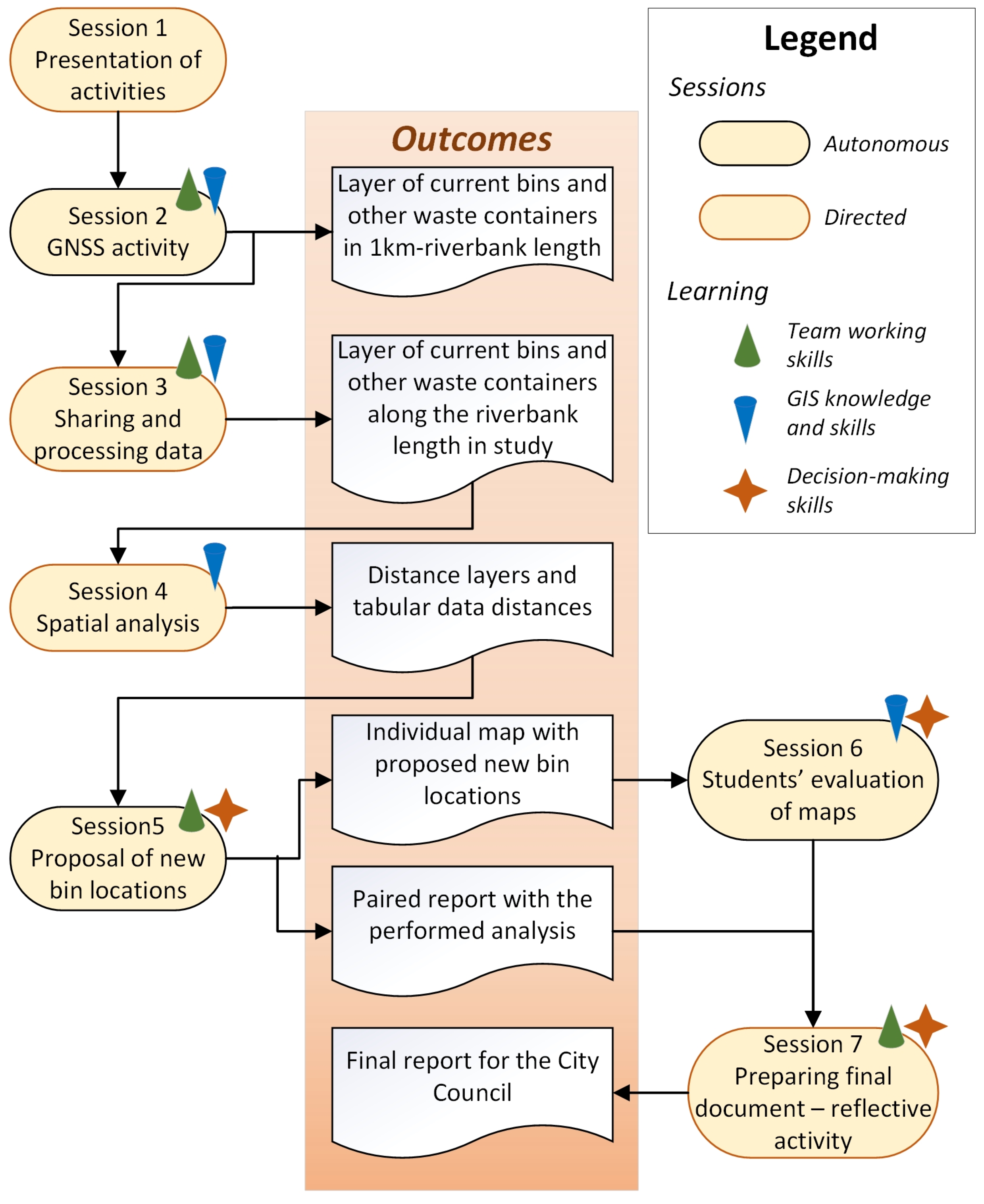
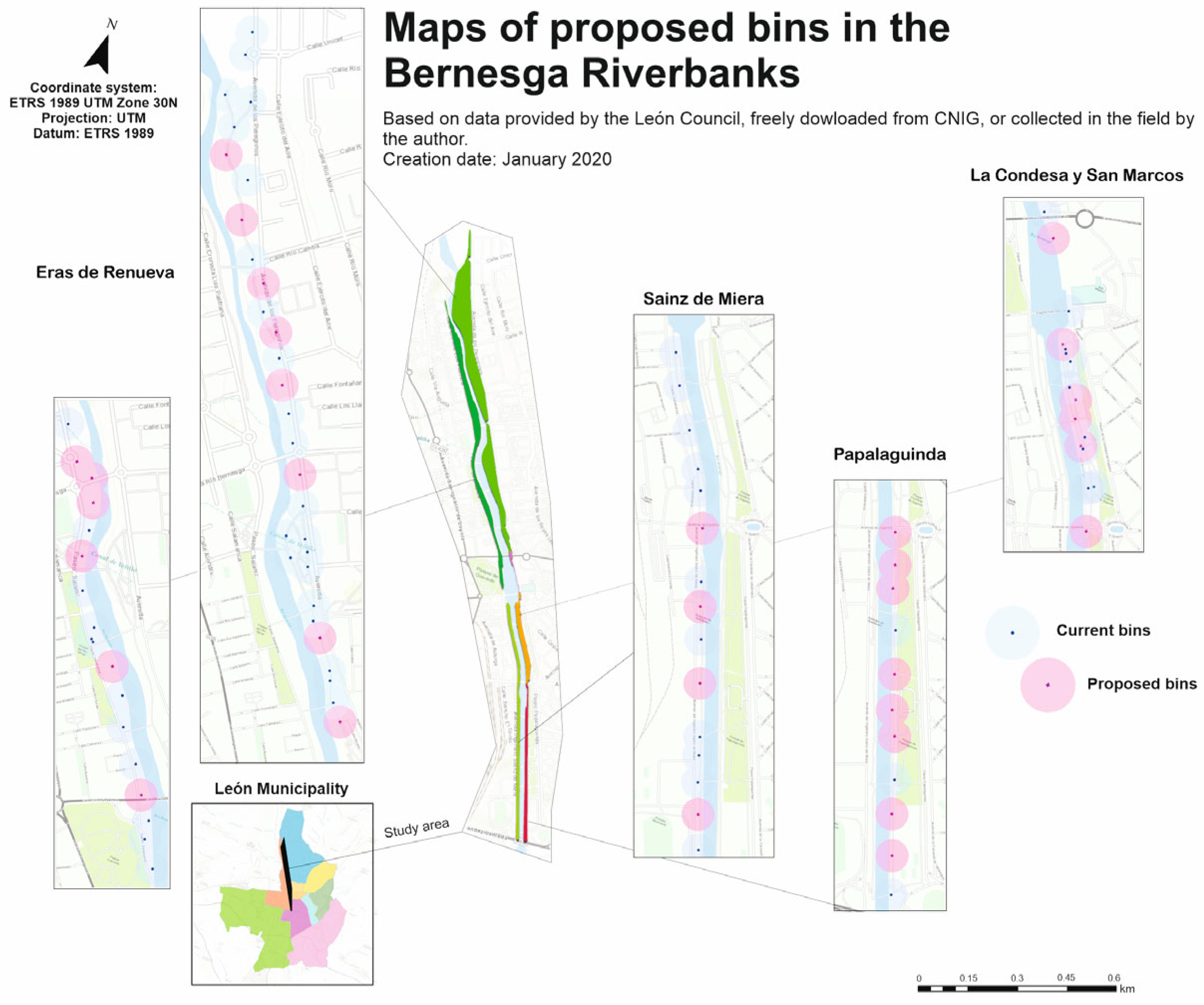
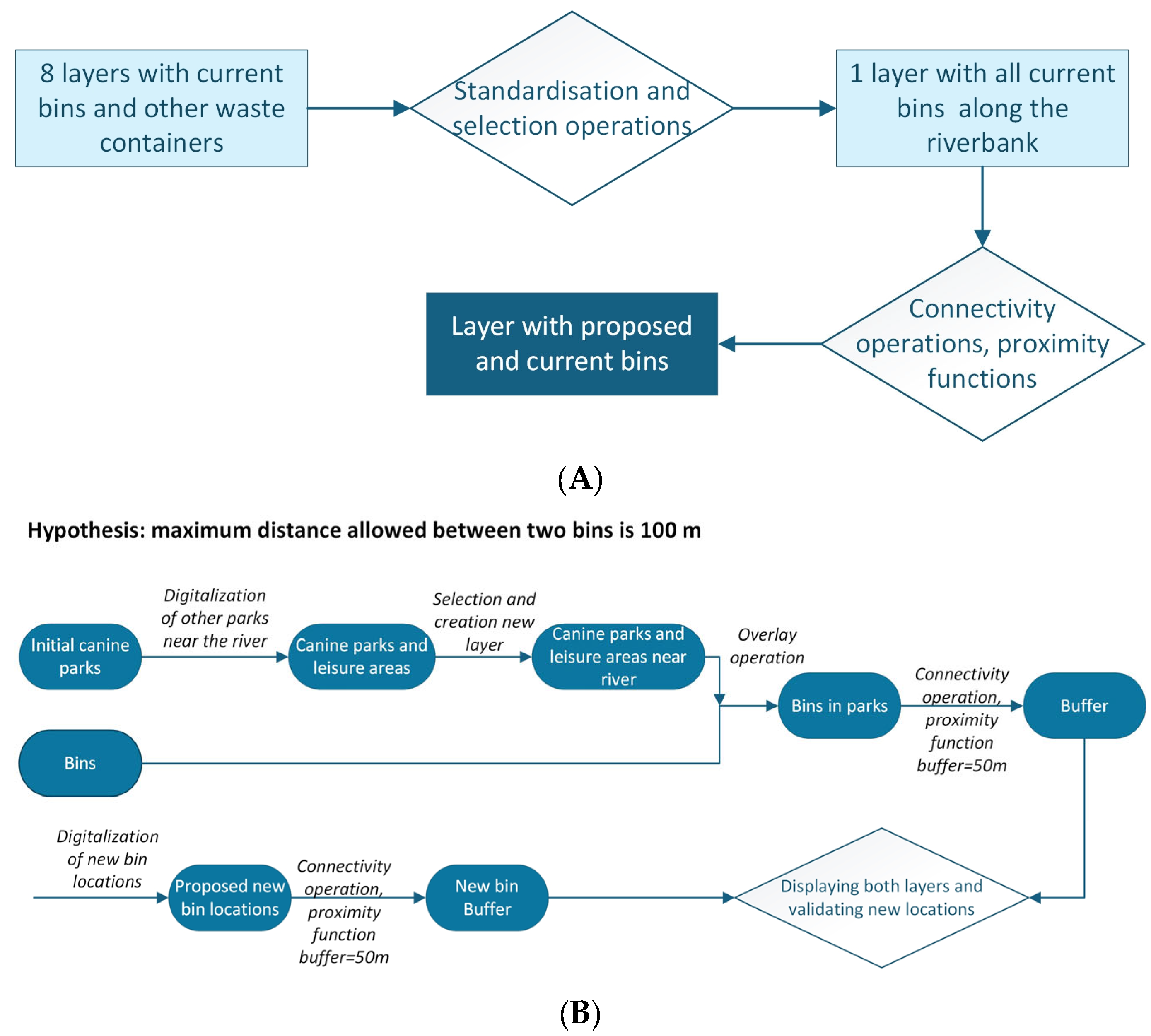
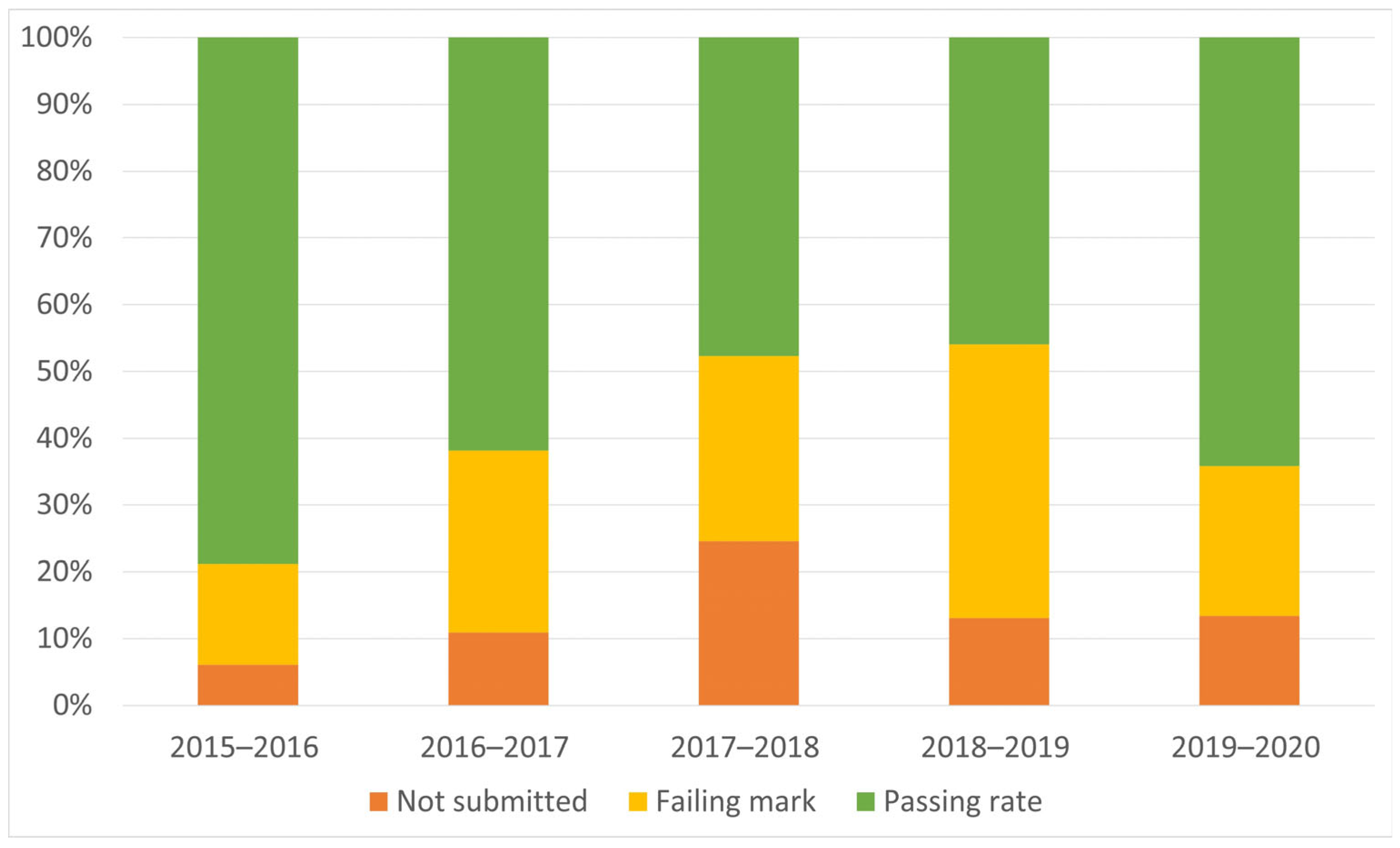
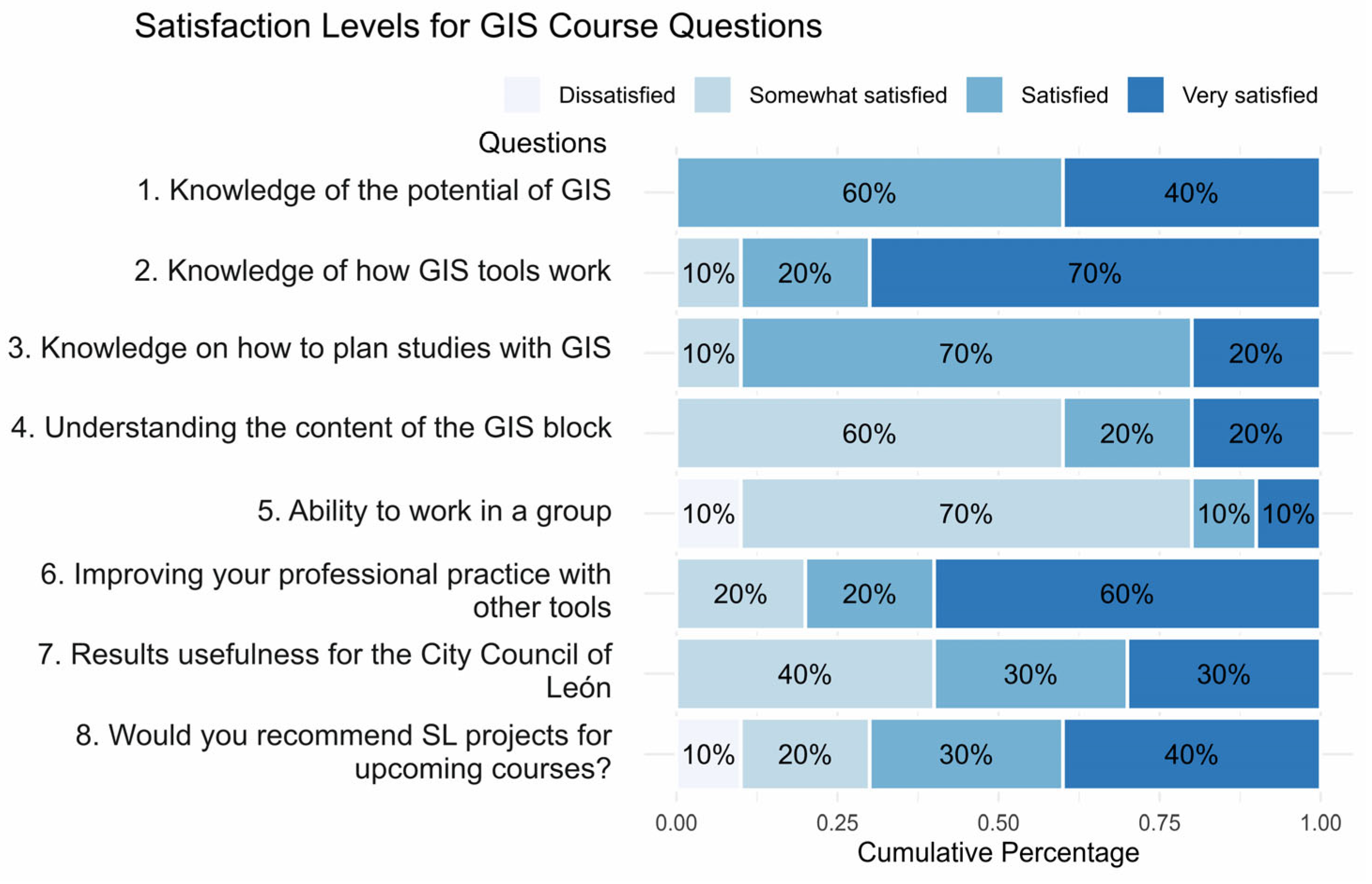
| Academic Course | 2014–2015 | 2015–2016 | 2016–2017 | 2017–2018 | 2018–2019 | 2019–2020 |
|---|---|---|---|---|---|---|
| % of re-enrolled students in the study course | 4 | 9 | 26 | 21 | 29 | 39 |
| Number of courses with >5% re-enrolled students in the Environmental Sciences degree | 26 | 29 | 27 | 33 | 35 | 32 |
| Main Goals | Specific Objectives Aimed at Students | What Is Being Evaluated |
|---|---|---|
| GIS knowledge/skills | Using a mobile application to locate points in the field using the GNSS | Final report by pairs Students’ evaluation of the maps. |
| Applying spatial operations using GIS to the data obtained by the students themselves | ||
| Determining satisfaction of the service | Drawing conclusions from the results obtained and how to present them to deliver to City Council’s environment technician | Conversation in a post meeting session with the technician of the Environmental Area of the City Council |
| Waste problem | Increasing awareness of the existing waste problems in cities | Discussions with students on-going during the entire project, with emphasis on session 7 |
| Student Survey Questionnaire |
|---|
| 1. Has your knowledge of the potential of GIS increased? |
| 2. Has your knowledge of how GIS tools work increased? |
| 3. Has your knowledge on how to plan studies with GIS increased? |
| 4. Did the rubbish bin training help you to understand the content of the GIS block of the Cartography, Remote Sensing, and GIS course? |
| 5. How much has your ability to work in a group improved? |
| 6. Do you think that other tools used in this project (Google Drive, GNSS) can help you in your professional practice? |
| 7. Will the achieved results be useful to the City Council of León? |
| 8. Would you recommend that this type of project be performed in the course in other academic years? |
| 9. Was there anything you particularly liked? |
| 10. Is there anything you would change from this project in the course? |
| Technician Survey Questionnaire |
|---|
| 1. Do you consider this type of projects to improve the academic training of the students? |
| 2. From a potential employer point of view, do you consider that the content of this project aligns with real-life professional research? |
| 3. Do you consider the results achieved to be able to help the Council to place new rubbish bins? |
| Category | 2017–2018 (%) | 2018–2019 (%) | 2019–2020 (%) |
|---|---|---|---|
| Not submitted | 25 | 13 | 11 |
| Failing mark | 35 | 49 | 30 |
| C mark | 31 | 31 | 44 |
| B mark | 9 | 7 | 15 |
| A mark | 0 | 0 | 0 |
| Passing rate (a + b + c marks) | 40 | 38 | 59 |
Disclaimer/Publisher’s Note: The statements, opinions and data contained in all publications are solely those of the individual author(s) and contributor(s) and not of MDPI and/or the editor(s). MDPI and/or the editor(s) disclaim responsibility for any injury to people or property resulting from any ideas, methods, instructions or products referred to in the content. |
© 2025 by the authors. Licensee MDPI, Basel, Switzerland. This article is an open access article distributed under the terms and conditions of the Creative Commons Attribution (CC BY) license (https://creativecommons.org/licenses/by/4.0/).
Share and Cite
Ferrer-Juliá, M.; Pereira, I.; Cruz, J.A.; García-Meléndez, E. A Service-Learning Project to Acquire GIS Skills and Knowledge: A Case Study for Environmental Undergraduate Students. Sustainability 2025, 17, 2276. https://doi.org/10.3390/su17052276
Ferrer-Juliá M, Pereira I, Cruz JA, García-Meléndez E. A Service-Learning Project to Acquire GIS Skills and Knowledge: A Case Study for Environmental Undergraduate Students. Sustainability. 2025; 17(5):2276. https://doi.org/10.3390/su17052276
Chicago/Turabian StyleFerrer-Juliá, Montserrat, Inés Pereira, Juncal A. Cruz, and Eduardo García-Meléndez. 2025. "A Service-Learning Project to Acquire GIS Skills and Knowledge: A Case Study for Environmental Undergraduate Students" Sustainability 17, no. 5: 2276. https://doi.org/10.3390/su17052276
APA StyleFerrer-Juliá, M., Pereira, I., Cruz, J. A., & García-Meléndez, E. (2025). A Service-Learning Project to Acquire GIS Skills and Knowledge: A Case Study for Environmental Undergraduate Students. Sustainability, 17(5), 2276. https://doi.org/10.3390/su17052276






